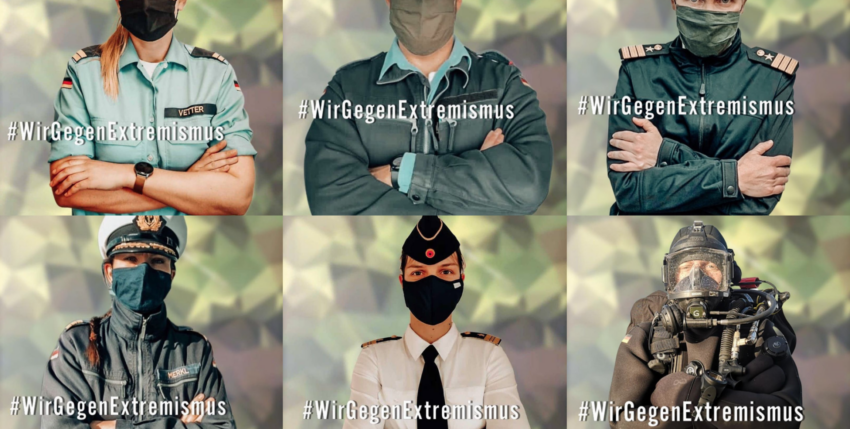It may only have been a week ago, but it seems as if a paradigm shift has taken place in security policy communication:
In the past, major topics, i.e. those that everyone should be talking about, have always been dictated by the Federal Ministry of Defence. This has recently been particularly evident in the employer brand campaigns.
Since last Tuesday, a campaign has been running that was initiated by soldiers in their role as private individuals: Activists from the so-called #socialmediadivision have taken a political stance under the slogan #weagainstextremism. Supported by images and videos showing the protagonists plus a steadily growing number of followers in an iconic way, the unmistakable message is spreading like wildfire on social networks. The tone is set on Instagram in particular, which is then spread via Twitter and LinkedIn.
Despite some criticism of the presentation and background of the campaign, it has been successful in that many people are talking about it. After the Minister of Defence, Annegret Kramp-Karrenbauer, tweeted her approval, an official statement from her authority promptly followed in the same way, which also reads positively.
Experts are now asking whether the campaign is merely a successful individual action or even marks the beginning of a new form of security policy "agenda setting" - based on the "bottom-up" principle. This refers to the consideration of the extent to which authorities still have the sole sovereignty to place high-profile topics in their own department. The #socialmediadivision shows what an (employee) network that functions according to different rules than institutional organisations such as trade unions or working groups is capable of.
What does this have to do with the maritime sector?
On the one hand, many marines of all ranks are involved in both the #socialmediadivision and its #wirgegenextremismus campaign. It is therefore by no means the case that the network is only supported by a specific career group. Moreover, the campaign creates a common Bundeswehr identity without allowing the branches of the armed forces to disappear into a sea of green polygons. In other words, all those comrades who took part in typical naval uniforms also sent a signal about how diverse the force is.
Secondly, the campaign should be a lesson to maritime organisations about the (external) power of their own employees. The question is therefore no longer necessarily which issues are politically important, but which ones are important to the organisation's own employees. Of course, safe sea routes are needed - but what does that mean for the individual crew member or harbour worker? And what connects them to each other?
Regardless of what you think of social media in general and the #socialmediadivision in particular, what happens there is no longer an echo chamber, but has ushered in a new phase of security policy communication.
Text: NIT team of authors, Photo: Campaign









3 responses
From a professional point of view, what is happening is a disaster. Associating people in uniform with the term "extremism". In terms of advertising psychology, that's exactly what sticks: "masked, uniform, extremism". I am not making myself popular with this statement, but it is basic marketing knowledge and the reason why toothpaste is not advertised with broken teeth or detergent with dirty laundry. So here's a suggestion for improvement: get rid of the masks, get rid of the term "extremism" in connection with the uniform. Show friendly people who stand up for others and communicate positively! The police show how it's done:
https://www.polizei-beratung.de/themen-und-tipps/extremismus/rechtsextremismus/praevention/
What you write is correct according to traditional understanding. However, the campaign is characterised precisely by reversing the signs. The images can also be understood as a "wall", along the lines of: "We won't let you into our army!" or "Don't mess with us!" The high reach achieved on Instagram in particular proves the creators right in that classic marketing logic plays a rather subordinate role in this sphere. Rather, being able to draw on a large and/or active network seems to be the decisive factor.
It is indisputable that soldiers have to take a stand against all forms of extremism, both in their professional and private lives! I consider the privately initiated campaign to be remarkable because people are talking about it. But this talk is not related to the topic of extremism. On closer inspection, it comes across as "breadth before depth". After just under two weeks of this campaign, pictures with masks of various protagonists have appeared and layouts based on a US cartoon series have been published. In addition, reference was only made to the BMI hotline. It gives the impression that the head of the department is being internally overwhelmed by a campaign against the content of which it can hardly and understandably put forward any arguments and which it can no longer contain. In addition to this, two young officers with the potential to present themselves, together with sufficient "followers" and therefore reach, act as mouthpieces.
It might have been better to actually organise this campaign with external support. Participation through technical expertise (BAMAD), accompanying flyers/notices in the offices in the BMVg division, sensitisation of managers, etc.. In my opinion, this would have been more effective and sustainable.
My conclusion: laudable intention, but in the end a media flash bang!